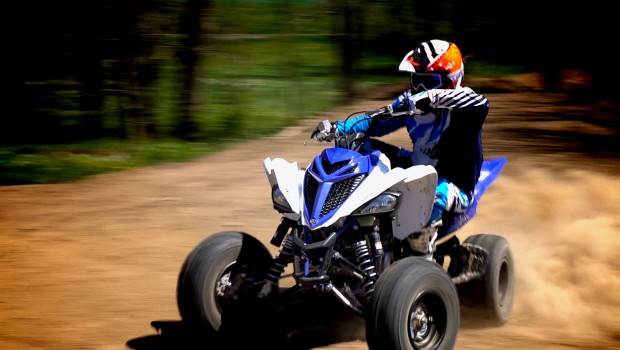Yamaha Raptor 700R Trail and Track Test Review: WITH VIDEO
Testing the versatility of the top-selling sport ATV
A great rider can ride any sport ATV well, but few machines make almost any rider or riding experience better. In our 2014 in-depth review of the Raptor 700R, we found it to lend itself beautifully to virtually any adult size rider with a little off-road experience. The Raptor’s phenomenal performance and handling thrills the highly experienced while its ride-ability provides a novice with the confidence to relax.
In 2015, Yamaha added 10% more horsepower focused on the bottom-end and midrange, making the engine feel even more unstoppable under load. New suspension settings featured slightly firmer spring rates front, with softer initial compression damping, reduced rebound damping, and travel was increased 2mm. The rear shock received 5mm more preload, plus slightly increased compression and rebound damping. New, taller front Maxxis tires were designed to roll more smoothly through bumps, while improving directional control in sand or loose dirt. Based in Ohio and testing in the sand of the gorgeous Oregon dunes, while the engine updates were apparent, the other changes were a little harder to fully evaluate.
With that in mind, we acquired a 2016 Yamaha 700R to put to the test on the trails, and even a motocross track in our neck of the woods, for further evaluation.
To evaluate the diversity of the Raptor’s performance capabilities, we hit the trails at Haspin Acres in Laurel, Indiana and a private practice track in Northern Kentucky. Test riders included 44-year-old, 5’8”, 196-lb, Rob Ray, a highly experienced play rider accustomed to pushing stock sport ATVs hard, and 18-year-old, 155-pound Jordan Trimble, a C class National Motocross competitor. Both are highly skilled riders, offering different backgrounds and perspective.
Engine
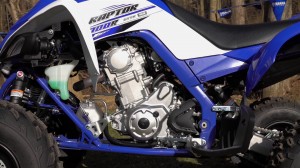
The Raptor 700R is powered by a liquid-cooled, 4-stroke engine, featuring a four-valve, double overhead cam head
The Raptor 700R is powered by a liquid-cooled, 4-stroke engine, featuring a four-valve, double overhead cam head design. It reaches its 686cc displacement with a bore and stroke of 102.0 x 84.0mm. Last year’s 10% horsepower gain was the result of a new single-exhaust-port head featuring a higher compression piston, raised from 9.2:1 to 10.0:1, in addition to a new cam profile, redesigned exhaust system with stainless steel header, and revised fuel injection settings. The compression ratio is still on the conservative side for a modern sport ATV, allowing for excellent reliability and the use of cheap pump gas, although we only burn premium or better fuel allowing for octane falloff over time. Yamaha even tweaked the counterbalances to keep the engine from picking up unwanted vibration. Needle bearing equipped rocker arms help reduce friction. A ceramic-coated cylinder reduces friction and heat buildup, while a forged aluminum piston, connecting rod, and crankshaft help reduce reciprocating mass for quicker throttle response.
The air/fuel mixture is handled by a Yamaha Fuel Injection system, delivered via a 44mm throttle body. Electric start brings the Raptor to life.

The engine is mated to a five-speed manual transmission with reverse. Final drive is handled by a DID x-ring chain.
The engine is mated to a five-speed manual transmission with reverse. In first gear, pull in the clutch and turn the knob on the right front fender to shift down to reverse. Final drive is handled by a DID x-ring chain, which Yamaha feels does a better job of keeping oil in and dirt out than a standard O-ring chain.
What has always made this engine so brilliant is that you can lug it around at a good pace or rev-it up and let it rip. Now, in our second go-round with the updated motor, it’s apparent it does both a bit better than before. The engine starts pulling immediately off idle with enough torque and horsepower below half throttle that it easily chugs its way up hills. Exiting turns a gear high, the engine snaps to life picking up speed with authority when you crack the throttle without the need to slip the clutch in search of RPMs.
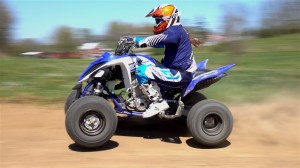
What has always made this engine so brilliant is that you can lug it around at a good pace or rev-it up and let it rip. Now, in our second go-round with the updated motor, it’s apparent it does both a bit better than before.
Barely reaching the midrange, power delivery is seamless as you enter the meat of the power band. Just get the big 700 spun up a little bit; it shreds corners and feels unstoppable on climbs. On the track or faster trails, the 700 builds RPMs quickly for a big single getting up to speed in a hurry. Power builds until you enter the top end of the power band, where it gradually starts tapering off. This keeps you upshifting before the rev limiter kicks in, increasing reliability. The Raptor reaches 60 mph in a hurry with plenty of acceleration left over. We never reached its 70+ mph top speed.

Not an anemic big-bore, this engine dishes out the torque you want from a big thumper, with controllable, yet surprising, responsiveness and rev-ability for its displacement
Not an anemic big-bore like some its departed competitors and predecessors, this engine dishes out the torque you want from a big thumper, with controllable, yet surprising, responsiveness and rev-ability for its displacement regardless of your riding style or terrain. While we wouldn’t recommend this machine for total beginners, its engine is friendly enough for those with basic skills to grow into with enough performance potential that it’s virtually impossible to grow out of.

Thanks to the manufacturers being forced to run their engine’s super lean at low RPMs to meet emission standards, the engine flared out a couple times when hitting the gas right off idle under 5mph. adding a fuel controller like the Dynojet Power Commander V, available through Yamaha’s GYTR line of accessories, will allow you to richen up the fuel map, which should make the engine more stall proof while adding horsepower across the board.
Thanks to the manufacturers being forced to run their engine’s super lean at low RPMs to meet emission standards, the Raptor’s engine has a slight hesitation off idle, which you don’t really notice when riding. It flared out a couple times when hitting the gas right off idle under 5mph when there was no forward momentum to keep the engine churning. It’s similar to the latest YFZ450R, kind of reminding us of riding a carbureted four-stroke before fuel injection made them nearly stall proof. While it’s definitely not necessary, adding a fuel controller like the Dynojet Power Commander V, available through Yamaha’s GYTR line of accessories, will allow you to richen up the fuel map, which should make the engine more stall proof while adding horsepower across the board. According to Fuel Customs and Dasa Racing, simply bolting on a well-tuned controller, intake, and exhaust yields around 5 more peak horsepower than an equally outfitted YFZ450R, while enjoying a broader power band and much more torque.
Gear ratios are nearly spot-on for taking advantage if the engine’s super wide power spread. First is low enough to tool around without touching the clutch, while fifth stretches into the speed of light. With a wide-ratio gearbox, we noticed a very small, unobtrusive gap between third and fourth gear in years past. That’s nearly disappeared with the engine’s added power and torque, pulling short shifts into fourth with more authority. Reverse is easy enough to engage and is geared appropriately.
Handling and Suspension
The Raptor was the first ATV to utilize a hybrid aluminum and steel chassis allowing Yamaha to maximize strength where needed, while saving weight where possible. A removable aluminum subframe, cast aluminum swingarm, and aluminum upper A-arms all add up in weight savings. Front-end geometry is very similar to the original YFZ450 with the A-arms closely together preventing unwanted bump steer.
KYB shocks at both ends feature spring preload, high and low-speed compression, and rebound damping adjustments. They control an impressive 9.1” of suspension travel up front and 10.1” of linkage-assisted rear travel.

KYB shocks at both ends feature spring preload, high and low-speed compression, and rebound damping adjustments. They control an impressive 9.1” of suspension travel up front and 10.1” of linkage-assisted rear travel.
The suspension received new settings at both ends last year to complement the increased power and new 1” taller, 22” front Maxxis tires. The rear shock received 5mm more spring preload, plus slightly stiffer compression and rebound damping. The front shocks received a small 2mm increase in travel. The dual-rate front springs feature a slightly stiffer spring rate throughout both stages. Compression damping was slightly reduced in the first part of the stroke and rebound damping decreased.
2015’s taller front tires were added for smoother rolling through bumps while a flatter profile and 20% stiffer sidewalls were designed to help reduce roll in corners. The 22×7-10 front and 20×10-9 rear tires are mounted on light aluminum wheels.
The Raptor measures in at 45.5” wide with a wheelbase of 50.4”. In spite of its big 700 engine, the Raptor is relatively light with a claimed wet weight of 422 pounds, only 17 pounds more than the nearly race-ready YFZ450R.
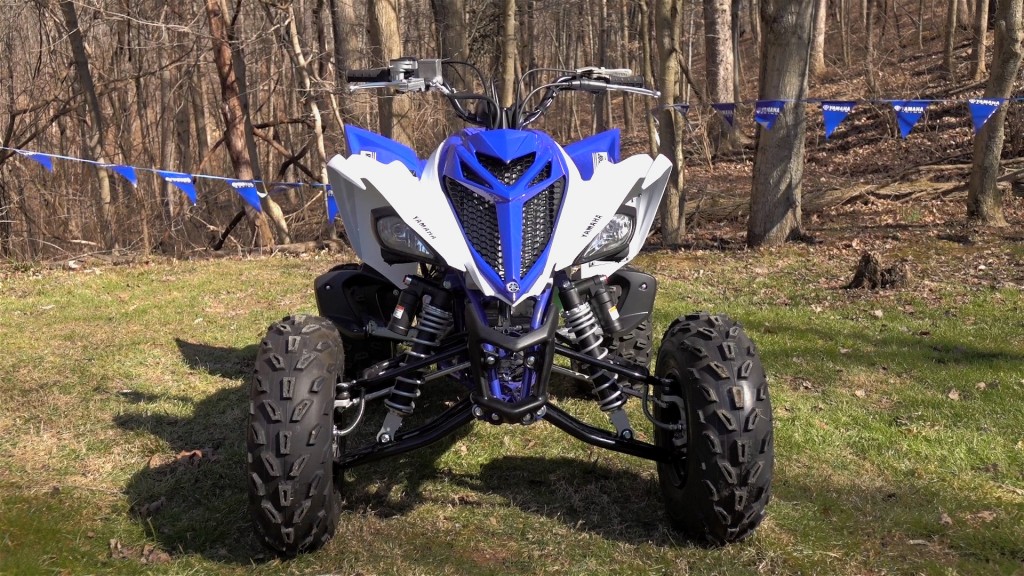
The Raptor measures in at 45.5” wide with a wheelbase of 50.4”. In spite of its big 700 engine, the Raptor is relatively light with a claimed wet weight of 422 pounds
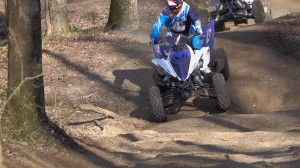
Over roots and rocks, both riders found the Raptor’s suspension action to be quite good right out of the box with adjustment in reserve to soften things up for lighter or more casual riders.
Over roots and rocks, both riders found the Raptor’s suspension action to be quite good right out of the box with adjustment in reserve to soften things up for lighter or more casual riders. The suspension does a good job of sheltering the rider from the square edged hits of the trail, keeping the tires in contact with the ground and biting. Overall, the ride is notably plusher than your typical 450–– a wonderful thing for long rides. In spite of their plush performance, the front shocks do a good job of keeping body roll under control in corners and on side hills while still remaining active over bumps helping to maintain stability and directional control.
On the track, we immediately found the need to add preload to the front shocks and increase their low-speed compression to four clicks from full stiff to better balance their bottoming resistance with the rear end. This is a little different than we remember from our 2014 test. While the jumps we were hitting were a little bigger this time around, the softer feeling front end may have also had to do with the shocks’ softer initial compression damping allowing the front shocks to build up more velocity on big hits.

Five minutes of tuning transformed the Raptor from trail plush into a whoop pounding, jump eating play machine for the track.
Five minutes of tuning transformed the Raptor from trail plush into a whoop pounding, jump eating play machine for the track. We give the rear shock an edge in dealing with imperfect landings. In whoops, the suspension doesn’t bottom out, deflect, and rarely does anything unexpected. If things start to get unsettled, hit the gas and the Raptor straightens right out and hauls. The bottom line is, these shocks are still very adjustable and a rider in the 160-200 pound range should be able to dial them in for anything from the trail to an occasional visit to the track.
You can save $500.00 by purchasing the base model Raptor 700, which features preload-adjustable only shocks in addition to a couple other tiny downgrades, but having experienced the added performance the700R’s fully adjustable KYB shocks provide, we feel they’re worth every penny.
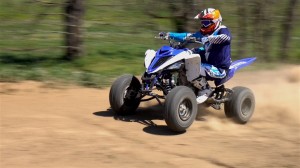
Steering is quick and accurate. The narrow 45.5” width and nimble steering let you bob and weave the 700 through tight trails. On wide-open trails and on the track, you can carry surprising speed through corners.
Steering is quick and accurate. The narrow 45.5” width and nimble steering let you bob and weave the 700 through tight trails. On wide-open trails and on the track, you can carry surprising speed through corners. Because of its taller motor and trail width, if you try and drive too hard into corners, the Raptor will start to two-wheel a little easier than a wider, lower 450cc class machine like the YFZ450R. With predictable handling and power on tap anywhere in the RPMs, you can simply lean forward, crack the throttle, and power-slide through turns at a higher rate of speed. The Raptor is equally happy being steered with the front and rear wheels.
Mild high-speed nervousness from years past seems to have been reduced a bit thanks to the Raptor’s taller front tires. Weight balance is good in the air or on the ground and the Raptor flies straight off of jumps. Smaller riders can feel at home on the Raptor, but a heavier rider will find it easier to get the most out of the chassis handling potential.

The brakes offer smooth, progressive action making it easy to stay hooked up on steep downhills, or lock the rear end up on demand.
Brakes
Separate hydraulic disc brakes with dual piston calipers reside at both ends. Stopping power is well balanced to the tremendous engine. The brakes offer smooth, progressive action making it easy to stay hooked up on steep downhills, or lock the rear end up on demand. The parking brake offers simple one hand operation.
Ergonomics

The Raptor’s cockpit is spacious. Riders just over 5 feet tall can manage the machine, while those at and above 6 feet still have plenty of room to move around.
The Raptor’s cockpit is spacious. Riders just over 5 feet tall can manage the machine, while those at and above 6 feet still have plenty of room to move around. While not YFZ450R slim, the midsection is easy to grip with your knees. The seat is plush enough for extended trail rides, yet firm and flat enough to easily move around on for aggressive riding. With a 32.7” seat height the relationship between the seat and pegs make getting in and out of the saddle easy as the day or your years wear on. 45mm wide pegs are just over 1 3/4” wide offering a solid, comfortable platform on which to stand. The front brake lever is adjustable in reach for different size hands. Overall, the cockpit puts you in a good position for aggressive riding, while its slightly higher seat and handlebar height keep in comfort and control on long rides.
Fit and Finish
Fit and finish are, for the most part, superb. The plastic is high-quality, although pretty susceptible to scratching. Boots mangle the finish of the lower rear fenders after just a couple rides. We’d like to see Yamaha start using matt plastic on the Raptor’s high wear areas like they do on sections of the YFZ450R and their utility ATVs. We would also like to see Yamaha use the same type of quick release fasteners on the Raptor’s bodywork that are used on the YFZ450R, which dramatically reduces the amount of time needed to remove and reinstall plastic for maintenance. Grease fittings allow you to keep bearings and bushings well lubed, pollutant free, and longer lasting. Air filter access is an easy, no tools procedure, although we wouldn’t mind the addition of a flange and clamp-on style filter for added security, similar to the one available through Yamaha’s GYTR Accessory line.
The Bottom Line
There are a number of us out here who already own the mighty Raptor 700R and a number of others who are simply missing out. In its decade of existence, the Raptor has seen a number of improvements, perhaps most significantly its early upgrade to higher-end adjustable shocks, and most recently, its notable improvement in engine performance. Going forward, we’d like to see a 49 or 50” side version of the machine, making the Raptor even better for the dunes, the desert, the track, and all of the 60” wide trails being cut for UTVs. We manage to have a great time on the trail with a 48.9” wide YFZ450R, so why should the Raptor be any different? Such a machine would make the decision between rebuilding your old Raptor and trading up to a shiny new one even more enticing for some.

n our opinion, no other four-wheeled machine delivers the fun and thrills of a fast, light, nimble handling sport ATV, and very few sport ATVs past or present can compete with the overall performance of the 2016 Yamaha Raptor 700R.
If taken care of, the Raptor is a very reliable machine. Its engine will last longer with less frequent oil changes than the typical 450. Just keep your air filter clean. Nimble handling, very adjustable, high-performance suspension, all-day comfort and a blisteringly fast, easy-to-manage engine make the Raptor 700R the ultimate ride- where you like, as fast as you like- Sport ATV. In our opinion, no other four-wheeled machine delivers the fun and thrills of a fast, light, nimble handling sport ATV, and very few sport ATVs past or present can compete with the overall performance of the 2016 Yamaha Raptor 700R.
| MSRP* | $8,299 – Team Yamaha Blue/White |
| Engine | |
| Engine Type | 686cc liquid-cooled w/fan, 4-stroke; SOHC, 4 valves |
| Bore x Stroke | 102.0mm x 84.0mm |
| Compression Ratio | 10.0:1 |
| Fuel Delivery | Yamaha Fuel Injection (YFI), 44mm |
| Ignition | 32 Bit ECU |
| Starting System | Electric |
| Transmission | 5-speed w/reverse; wet multiplate clutch |
| Drive Train | 2WD; sealed O-ring chain, eccentric adjustment |
| Chassis | |
| Suspension / Front | Independent double wishbone w/piggyback High-/Lo-speed compression, rebound and threaded preload adjustment, 9.1-in travel |
| Suspension / Rear | Cast aluminum swing arm w/rebound, High-/Lo-speed compression and threaded preload adjustment, 10.1-in travel |
| Brakes / Front | Dual ventilated hydraulic disc, twin piston |
| Brakes / Rear | Ventilated hydraulic disc, twin piston |
| Tires / Front | Maxxis® AT22 x 7-10 |
| Tires / Rear | Maxxis® AT20 x 10-9 |
| Dimensions | |
| L x W x H | 72.6 x 45.5 x 43.9 in |
| Seat Height | 32.7 in |
| Wheelbase | 50.4 in |
| Ground Clearance | 9.5 in |
| Fuel Capacity | 2.9 gal |
| Wet Weight | 422 lb |
| Other | |
| Lighting | Dual 30W Krypton multireflector headlights & 3.9/0.5W LED brakelight |
| Warranty | 6 Month (Limited Factory Warranty) |
2016 Yamaha Raptor 700R Ratings
Summary: If taken care of, the Raptor is a very reliable machine. Its engine will last longer with less frequent oil changes than the typical 450. Just keep your air filter clean. Nimble handling, very adjustable, high-performance suspension, all-day comfort and a blisteringly fast, easy-to-manage engine make the Raptor 700R the ultimate ride- where you like, as fast as you like- Sport ATV. In our opinion, no other four-wheeled machine delivers the fun and thrills of a fast, light, nimble handling sport ATV, and very few sport ATVs past or present can compete with the overall performance of the 2016 Yamaha Raptor 700R.

